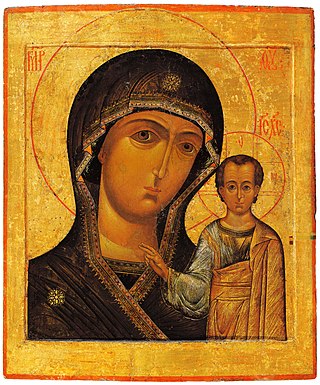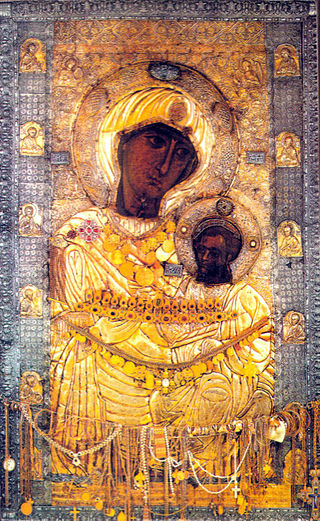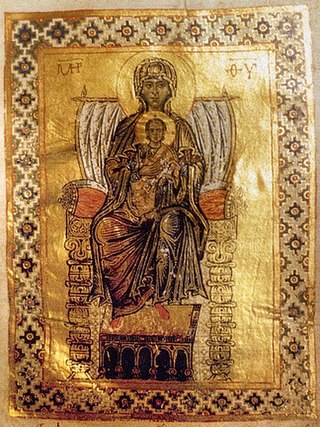This article lists icons of the Theotokos of St. Theodore having historical or cultural value, or housed in scholarly museums or collections.
| Title | Place of creation (city, state) | Date | Medium | Size | Location before 1917 | Current Location | Image |
|---|---|---|---|---|---|---|---|
| Theotokos of St. Theodore from Nikolay Gostinsky Cruch [1] | Russia (most likely Moscow) | End of 17th century | Wood, Primer, Tempera | 42.0 cm (16.5 in) х 34.5 cm (13.6 in) | Nikolay Gostinsky Cruch, Moscow Kremlin, Russia | Moscow Kremlin, collection J-384, number 2754 |  |
| Theotokos of St. Theodore [2] | Russia | 18th century | Wood, Primer, Tempera | 31.5 cm (12.4 in) х 27.5 cm (10.8 in) | Unknown | Unknown; through Sotheby's |  |
| Theotokos of St. Theodore from Kostroma [3] | Russia, Kostroma, iconographer is Georgy Avraamov | 1703 | Wood, Primer, Tempera | 64.3 cm (25.3 in) х 49.0 cm (19.3 in) | in Kostroma | State Historical Museum, Russia number 58271 i VIII 3740 |  |
| Theotokos of St. Theodore from workroom of Chichikovs [4] | Russia, Moscow, workshop of Chichikovs | 1904 | Wood, Primer, Tempera | 31.0 cm (12.2 in) х 28.5 cm (11.2 in) | Unknown | Unknown |  |
| Theotokos of St. Theodore from Yaroslavl [5] | Russia, Yaroslavl | First half of 19th century | Wood, Primer, Tempera | 66.4 cm (26.1 in) х 51.3 cm (20.2 in) | Unknown | Yaroslavl Art Museum |  |
| Theotokos of St. Theodore from Russian Icons museum [6] | Russia | 1850 | Wood, Primer, Tempera | Unknown | Russian Icons museum |  | |
| Theotokos of St. Theodore from Tsarskoye Selo [7] | Russia, Moscow, iconographer is Nemirov-Kolodkin's workroom | 1903, [8] Begin of 20th century | Wood, Tempera, Silver, Repoussé and chasing | 31.4 cm (12.4 in) х 27.0 cm (10.6 in) | Alexander Palace's Cruch in Tsarskoye Selo | State Hermitage Museum, St. Petersburg, store number ERO-8754 |  |
| Theotokos of St. Theodore in a silver frame [9] | Russia, Yaroslavl | First half of 18th century | Wood, Tempera, Silver, Gilding, Repoussé and chasing | 69.0 cm (27.2 in) х 50.0 cm (19.7 in) | Unknown, has arrived from the Russian Museum of Ethnography in 1941 | State Hermitage Museum, St. Petersburg, store number ERO-7139 |  |
| Embroidered Theotokos of St. Theodore [10] | Russia | 18th century | Canvas, Embroidery (silk and metal threads) | 26.0 cm (10.2 in) х 19.0 cm (7.5 in) | Ivan A.Galnbek's collection of icons | State Hermitage Museum, St. Petersburg, store number ERP-922 |  |
| Theotokos of St. Theodore in the gold salary [11] | Russia | 17th century | Wood, Tempera, Silver, Gold, Sapphires, Diamonds, Rubies, Emeralds, Pearls | 36.0 cm (14.2 in) х 27.7 cm (10.9 in) | Alexander Palace's Cruch in Tsarskoye Selo | State Hermitage Museum, St. Petersburg, store number ERO-8846 |  |
| Theotokos of St. Theodore found in 1239 | Russia, under the legend it is wonderfully found | 1239 | Wood, Primer, Tempera | Uspensky cathedral in Kostroma | Revival church on the Jungle in Kostroma. The icons riza is in other place |  | |
| Theotokos of St. Theodore found in 1239. Riza | Russia, Kostroma, master Ivan Serebryannikov (1756–1795). | Second half of 18th century | Silver | Uspensky cathedral in Kostroma | Any of the Russian museums, the icon is in other place |  | |
| Theotokos of St. Theodore of 1759 [12] | Russia, Kostroma | 1759 | Wood, Primer, Tempera | 65.0 cm (25.6 in) х 50.0 cm (19.7 in) | Dormition Cruch, Moscow | Tretyakov Gallery, Moscow, store number DR-40 |  |
| Theotokos of St. Theodore with miracles [13] | Russia, Kostroma | Second half of 18th century | Wood, Primer, Tempera | 36.0 cm (14.2 in) х 31.0 cm (12.2 in) | Unknown | Kolomenskoye, Moscow, store number J-1454 |  |
| Theotokos of St. Theodore with miracles of 19th century [14] | Russia, Kostroma | 19th century | Wood, Primer, Tempera | Unknown | Dmitry Bondarenko's collection of icons |  |















